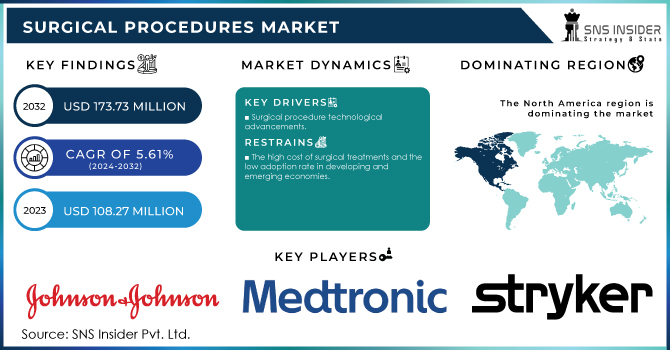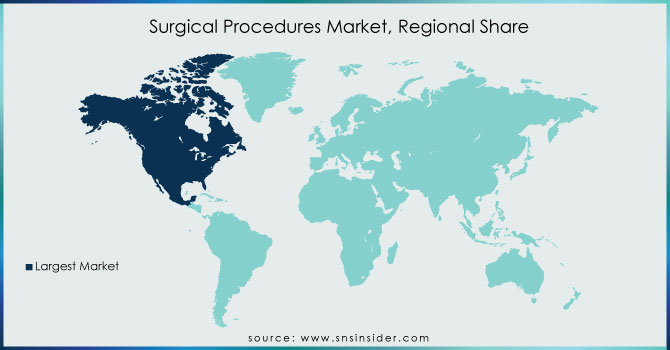Surgical Procedures Market Scope And Overview:

To Get More Information on Surgical Procedures Market - Request Sample Report
The Surgical Procedures Market Size was valued at USD 108.27 Million in 2023 and is expected to reach USD 173.73 Million by 2032 and grow at a CAGR of 5.61% over the forecast period 2024-2032.
A surgical procedure is an intrusive treatment that has the essential notion of a physical intervention on tissues/organ systems for diagnostic or therapeutic objectives. A technique is typically called operational when a surgeon cuts a tissue or closes a previously incurred wound. Additional measures things do not need to be included in this category, such as angioplasty or endoscopy, such as anesthetic and antiseptic. Surgery can be performed using conditions, traditional surgical equipment, saturation, or stapling. Both kinds of surgery is considered an invasive procedure. A minimally invasive procedure often includes a small incision not infiltrate the removed structure.
MARKET DYNAMICS
DRIVERS
-
Surgical procedure technological advancements
The United States is regarded as a leader in medical technology innovation; most innovative surgical goods and devices are created and manufactured in the United States. The rapid expansion of operations has been made possible by considerable advances in medical technology, which have partially eliminated some of the technical and clinical obstacles connected with surgical procedures. To offer the best possible care for their patients, hospitals and healthcare systems spend extensively in cutting-edge technology.
RESTRAIN
-
The high cost of surgical treatments and the low adoption rate in developing and emerging economies
OPPORTUNITY
-
Outpatient Surgery is gaining popularity
Ambulatory surgery centers (ASCs) are self-contained clinics that specialize in non-hospital surgical, diagnostic, and preventative services. Because of technical improvements such as minimally invasive surgical procedures and value-based care incentives, medical operations are increasingly being performed in these outpatient clinics. In addition, health systems have been acquiring or partnering with physicians and medical practices, which has increased the number of services provided in outpatient settings. The cost-effectiveness of ASCs saves governments, third-party payers, and patients money. According to a study conducted by Healthcare BlueBook (a provider of data for healthcare services) and HealthSmart (a provider of health plans for self-funded employers), ASCs reduce the cost of outpatient surgery by USD 38 billion per year because these facilities provide a lower-cost site of care than hospital outpatient departments.
CHALLENGES
-
Complications caused by surgical procedures
Surgical operations have few problems, which result in higher healthcare costs. Most surgical complications are mild, but others can be fairly dangerous. The patient's discomfort following surgery is determined by a variety of factors, including the type of surgery. Typical side effects of general anesthesia include nausea and vomiting, sore throat produced by the tube placed in the windpipe for breathing during surgery, soreness, pain, and swelling at the incision site or slight pain surrounding the IV site, and restlessness and sleeplessness, among other things. Certain procedures, however, can be high risk due to patient-specific or operation-specific considerations. Certain medical conditions can raise the risks of surgery. Obesity, postoperative delirium, postoperative cognitive dysfunction (POCD), and sleep apnea are some of the key patient-specific hazards connected with surgical operations.
IMPACT OF RUSSIAN UKRAINE WAR
This war comes to a country whose health-care system is still far from Western standards due to inadequate government financing, heavy centralization, and generally antiquated equipment. For example, operating microscopes, which are required for surgical treatment of peripheral nerve damage, are in low supply. The indiscriminate strikes on civilian infrastructure in this battle also harmed health care facilities, such as the Central City Hospital in Vuhledar, which suffered at least three casualties, worsening the care of the wounded. The most common injuries among survivors of bombings and missile attacks are shrapnel wounds, bone fractures, and burns.
IMPACT OF ONGOING RECESSION
The economic crisis has reduced hospital funds available, including reimbursement rates, contributions, and revenue (in Greece and the United States). Furthermore, hospitals' patient care losses grew as a result of less ambulatory care and elective procedures. Furthermore, income from non-patient care activities fell following the economic downturn. All of these variables contributed to an increase in out-of-pocket and informal payments. Hospital closures, admitting fewer patients with acute diseases, limiting drug prescription, and forcing patients to source consumables and drugs from outside the hospital have all resulted in an indirect rise in patients' financial burden.
KEY SEGMENTS
By Type
-
Gastrointestinal Surgical Procedures
-
Cardiovascular Surgical Procedures
-
Dental Surgical Procedures
-
Cosmetic Surgical Procedures
-
Urologic Surgical Procedures
-
Ophthalmic Surgical Procedures
-
Orthopedic Surgical Procedures
-
ENT Surgical Procedures
-
Obstetric
-
Gynecologic Surgical Procedures
-
Other Surgical Procedures
In 2022, the Services segment is expected to held the highest market growth rate during the forecast period due to an increase in the prevalence of oral disorders, increased awareness of oral care, and an aging population with related tooth loss. Furthermore, among persons 65 and older, the incidence of dental implants has increased sevenfold, contributing to an increase in demand for dental implant surgeries.
By Channel
-
Physician Offices
-
Hospitals
-
Inpatient Surgeries
-
Outpatient Surgeries
-
Ambulatory Surgery Centre
REGIONAL ANALYSES
North America held a significant market share in 2022. The surgical procedure market in the United States is driven by best-in-class health care infrastructure equipped with innovative and cutting-edge equipment and technologies, as well as increasing healthcare spending by its citizens and better reimbursement policies by the United States government for healthcare services. The surgical procedure market in the United States is predicted to develop in the near future, owing to the country's growing senior population, rising cases of lifestyle-related health problems among its residents, and sustained favorable government policies for healthcare expenditure.
Asia-Pacific is witness to expand fastest CAGR rate during the forecast period thanks to the significant expansion in the medical sector and decreased price of treatment in the region.

Do You Need any Customization Research on Surgical Procedures Market - Enquire Now
REGIONAL COVERAGE
North America
-
US
-
Canada
-
Mexico
Europe
-
Eastern Europe
-
Poland
-
Romania
-
Hungary
-
Turkey
-
Rest of Eastern Europe
-
-
Western Europe
-
Germany
-
France
-
UK
-
Italy
-
Spain
-
Netherlands
-
Switzerland
-
Austria
-
Rest of Western Europe
-
Asia Pacific
-
China
-
India
-
Japan
-
South Korea
-
Vietnam
-
Singapore
-
Australia
-
Rest of Asia Pacific
Middle East & Africa
-
Middle East
-
UAE
-
Egypt
-
Saudi Arabia
-
Qatar
-
Rest of Middle East
-
-
Africa
-
Nigeria
-
South Africa
-
Rest of Africa
-
Latin America
-
Brazil
-
Argentina
-
Colombia
-
Rest of Latin America
Key Players
The major players are Johnson & Johnson, Medtronic, Stryker Corporation, Becton, Dickinson and Company (BD), Intuitive Surgical, Zimmer Biomet Holdings, Olympus Corporation, Abbott Laboratories, Boston Scientific Corporation, Smith & Nephew, Danaher Corporation, Karl Storz SE & Co. KG, and Others.
RECENT DEVELOPMENTS
In June 2022, Xenco Medical extended their surgical equipment portfolio for Ambulatory Surgical Centers across the United States. The company received FDA approval and launched its Multilevel Cervikit. It is a single-use cervical spine technique that includes a comprehensive suite of implants and single-use devices for the 2nd, 3rd, and 4th levels of the anterior cervical spine procedures.
| Report Attributes | Details |
|
Market Size in 2023 |
US$ 108.27 million |
|
Market Size by 2032 |
US$ 173.73 million |
|
CAGR |
CAGR of 5.61% From 2024 to 2032 |
|
Base Year |
2023 |
|
Forecast Period |
2024-2032 |
|
Historical Data |
2020-2022 |
|
Report Scope & Coverage |
Market Size, Segments Analysis, Competitive Landscape, Regional Analysis, DROC & SWOT Analysis, Forecast Outlook |
|
Key Segments |
By Type (Gastrointestinal Surgical Procedures, Cardiovascular Surgical Procedures, Dental Surgical Procedures, Cosmetic Surgical Procedures, Urologic Surgical Procedures, Ophthalmic Surgical Procedures, Orthopedic Surgical Procedures, ENT Surgical Procedures, Obstetric, Gynecologic Surgical Procedures, Other Surgical Procedures), By Channel (Physician Offices, Hospitals, Ambulatory Surgery Centre) |
|
Regional Analysis/Coverage |
North America (US, Canada, Mexico), Europe (Eastern Europe [Poland, Romania, Hungary, Turkey, Rest of Eastern Europe] Western Europe] Germany, France, UK, Italy, Spain, Netherlands, Switzerland, Austria, Rest of Western Europe]), Asia Pacific (China, India, Japan, South Korea, Vietnam, Singapore, Australia, Rest of Asia Pacific), Middle East & Africa (Middle East [UAE, Egypt, Saudi Arabia, Qatar, Rest of Middle East], Africa [Nigeria, South Africa, Rest of Africa], Latin America (Brazil, Argentina, Colombia Rest of Latin America) |
|
Company Profiles |
Johnson & Johnson, Medtronic, Stryker Corporation, Becton, Dickinson and Company (BD), Intuitive Surgical, Zimmer Biomet Holdings, Olympus Corporation, Abbott Laboratories, Boston Scientific Corporation, Smith & Nephew, Danaher Corporation, Karl Storz SE & Co. KG |
|
Key Drivers |
•Surgical procedure technological advancements |
|
Market Challenges |
•Complications caused by surgical procedures |

